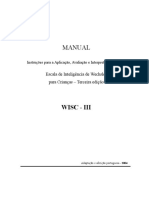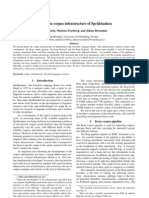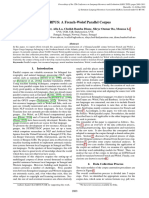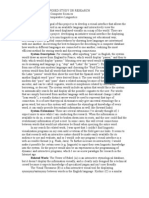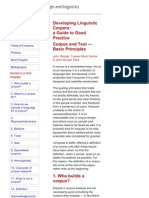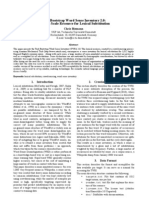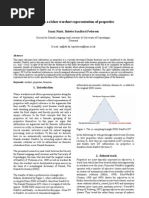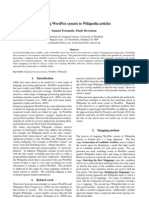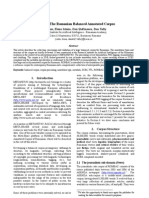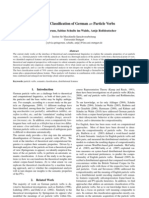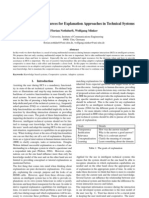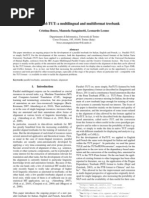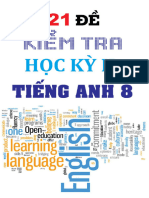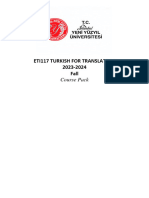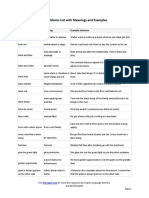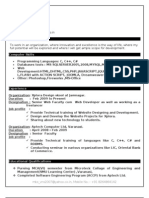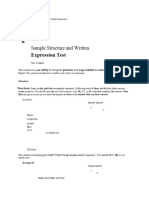The Open Lexical Infrastructure of SPR Akbanken: Lars Borin, Markus Forsberg, Leif-J Oran Olsson and Jonatan Uppstr Om
The Open Lexical Infrastructure of SPR Akbanken: Lars Borin, Markus Forsberg, Leif-J Oran Olsson and Jonatan Uppstr Om
Uploaded by
acouillaultCopyright:
Available Formats
The Open Lexical Infrastructure of SPR Akbanken: Lars Borin, Markus Forsberg, Leif-J Oran Olsson and Jonatan Uppstr Om
The Open Lexical Infrastructure of SPR Akbanken: Lars Borin, Markus Forsberg, Leif-J Oran Olsson and Jonatan Uppstr Om
Uploaded by
acouillaultOriginal Title
Copyright
Available Formats
Share this document
Did you find this document useful?
Is this content inappropriate?
Copyright:
Available Formats
The Open Lexical Infrastructure of SPR Akbanken: Lars Borin, Markus Forsberg, Leif-J Oran Olsson and Jonatan Uppstr Om
The Open Lexical Infrastructure of SPR Akbanken: Lars Borin, Markus Forsberg, Leif-J Oran Olsson and Jonatan Uppstr Om
Uploaded by
acouillaultCopyright:
Available Formats
The open lexical infrastructure of Spr akbanken
Lars Borin, Markus Forsberg, Leif-J oran Olsson and Jonatan Uppstr om
Spr akbanken, University of Gothenburg, Sweden {lars.borin, markus.forsberg, leif-joran.olsson, jonatan.uppstrom}@svenska.gu.se Abstract
We present our ongoing work on Karp, Spr akbankens (the Swedish Language Bank) open lexical infrastructure, which has two main functions: (1) to support the work on creating, curating, and integrating our various lexical resources; and (2) to publish daily versions of the resources, making them searchable and downloadable. An important requirement on the lexical infrastructure is also that we maintain a strong bidirectional connection to our corpus infrastructure. At the heart of the infrastructure is the SweFN++ project with the goal to create free Swedish lexical resources geared towards language technology applications. The infrastructure currently hosts 15 Swedish lexical resources, including historical ones, some of which have been created from scratch using existing free resources, both external and in-house. The resources are integrated through links to a pivot lexical resource, SALDO, a large morphological and lexical-semantic resource for modern Swedish. SALDO has been selected as the pivot partly because of its size and quality, but also because its form and sense units have been assigned persistent identiers (PIDs) to which the lexical information in other lexical resources and in corpora are linked. Keywords: lexicon, infrastructure, Swedish language resources
1.
1
Introduction
Spr akbanken (the Swedish Language Bank) is research unit working on the development of (Swedish) linguistic resources and tools, and methodologies for using the resources in research in language technology and a number of other disciplines. Spr akbanken was established in 1975, and over the years has accumulated a number of lexical resources, but due to the normal format of research in our eld, with funding granted mainly for shorter-term (two to four years) projects, many of these resources have lived a forgotten and slowly deteriorating life. However, in the last few years, Spr akbanken has been able to start changing this negative trend through projects such as SweFN++2 (Borin et al., 2010a; Borin et al., 2009), a project with the objective to create, curate, and integrate free Swedish lexical resources with the explicit goal of making them usable for language technology applications, and META-NORD,3 a broad ECfunded European collaboration with the aim of upgrading and harmonizing language resources and tools and making them available across Europe. As part of this work, we are developing an open lexical infrastructure, presented in this paper.
2.
The lexical resources
The infrastructure currently hosts 15 lexical resources for language technology use, some of which have been created from scratch using existing free resources, both external and in-house. For example, the lexical resource Swesaurus, a Swedish wordnet, is being built using not only in-house but also external resources, such as Synlex (Kann and Rosell, 2006), the Swedish Wiktionary,4 and more indirectly, from semantic relations extracted from Princeton
1
<http://spraakbanken.gu.se> <http://spraakbanken.gu.se/swefn> 3 <http://www.meta-nord.eu/> 4 <http://sv.wiktionary.org>
2
WordNet (Fellbaum, 1998) through links between SALDO (see below) and Core Princeton WordNet (Boyd-Graber et al., 2006). The lexical infrastructure has one primary lexical resource, a pivot, to which all other resources are linked. This is SALDO5 (Borin and Forsberg, 2009), a large (123K entries and 1.8M wordforms), freely available morphological and lexical-semantic lexicon for modern Swedish. It has been selected as the pivot partly because of its size and quality, but also because its form and sense units have been assigned persistent identiers (PIDs) to which the lexical information in other resources are linked. The standard scenario for a new resource to be integrated into the infrastructure is to (partially) link its entries to the sense PIDs of SALDO. This typically has the effect that the ambiguity of a resource becomes explicit: the bulk of the resources associate lexical information to PoS-tagged baseforms, information not always valid for all the senses of that baseform. This is natural since most of the resources have initially been created for human consumption, and a human has usually no problem dealing with this kind of underspecication. Some of these ambiguities can be resolved automatically especially if information from several resources are combined but in the end, manual work is required for complete disambiguation. The infrastructure also includes historical lexical resources (Borin et al., 2010b), where the starting point is four digitized paper dictionaries: one 19th century dictionary, and three Old Swedish dictionaries. To make these dictionaries usable in a language technology setting, they need morphological information, a work that has been begun in the CONPLISIT project for 19th century Swedish (Borin et al., 2011) and in a pilot project for Old Swedish (Borin and Forsberg, 2008). Linking SALDO to the historical resources is naturally a much more complex task than linking to the modern resources, especially when moving further back in time.
5
<http://spraakbanken.gu.se/saldo>
3598
The promise is that a successful (but possibly partial) linking introduces the possibility to mirror the modern lexicalsemantic relations onto the historical resources, so that, e.g., a WordNet-like resource for Old Swedish becomes available for use.
3.
An open lexical infrastructure
The lexical infrastructure has two main functions: (1) to support the work on creating, curating, and integrating the lexical resources; (2) and to publish daily versions of the resources, making them searchable and downloadable. A pervasive theme of the infrastructure is openness, which may be seen as a philosophical stance we believe that research should be carried out in the open to enable inspection and increased collaboration. Openness pervades the infrastructure, in the use of open standards (see the next section) and open-content licenses, as well as the daily publication of not only the resources but everything else that is available in-house, such as formal test protocols and change history. Below is an example showing the most recent change history at the time of writing for two of the lexical resources, where we can see that Containers and Artifact were the frames most recently worked on in the Swedish Framenet, and that the word h astsova (sleeping while standing, literally horse-sleep) was the latest addition to SALDO.
is that we maintain a strong bidirectional connection to the corpus infrastructure (Borin et al., 2012). This requirement includes ensuring up-to-date lexical annotations of the corpus material together with facilities to enhance the corpus search with lexical information,6 and conversely, the use of examples and statistics from the corpora in the lexical infrastructure. The daily publication of the resources is accomplished using the versioning system Subversion.7 The resources together with accompanying information are published through Spr akbankens website using the content management system Drupal.8 Moreover, the lexical resources are imported into the infrastructure and published via a web service used by the search interface (see Sec. 5.). The web service is open for others to use, and provides a convenient way of accessing the lexical information programmatically.
4.
Upgrading the lexical resources to LMF
Yet another example, a snippet of a test protocol showing formal requirements that have been violated in the Swedish Framenet here, senses appearing in more than one frame.
Since one of the main objectives of Spr akbanken is to make the free resources accessible to the outside world, we strive to use standardized data models and le formats as far as possible. And thanks to our involvement in the project META-NORD,9 we have been able to upgrade our lexical resources to Lexical Markup Framework, LMF, which is an ISO standard published in 2008 (ISO 24613) (ISO, 2008). The aim of the standard is to provide an intermediate format for lexical data exchange, and its specication captures a wide range of concepts, including description of morphosyntactic and lexical-semantic information. Upgrading some of our more semantically orientated resources to LMF has turned out to be quite complicated, although still possible. The main obstacle has been that, even though the framework contains mechanisms for specifying semantic information, the model is based upon the assumption that lexical entries are formal entities expressing one or more senses, not semantic entities having one or more formal realizations. In more traditional lexicographic terms, LMF is geared towards semasiological rather than onomasiological lexical resources. This does not mesh well with the resources that contain mostly semantic information. For example, the Swedish Framenet has the semantic frame as the natural conceptual unit, but to be able to t the information into LMF, we had to split the frame into several entries. Moreover, the frame data is not enough to validate as LMF on its own, since it only refers to the sense PIDs of SALDO, so a choice had to be made whether to combine all elds in SALDO and Framenet into one bigger resource, or to duplicate some or all of the concerned SALDO entries in the Framenet LMF. We have settled for adding placeholders for the SALDO senses in the Framenet LMF, which are linked to the frame representations, thus
6 For instance, in the corpus interface we provide a Related words box where semantically related words to the search term are provided from SALDO, but only such words that are actually present in the corpora as shown by the morphological analysis and disambiguation module in the corpus processing pipeline. 7 <http://subversion.tigris.org/> 8 <http://drupal.org> 9 <http://www.meta-nord.eu/>
An important requirement on the lexical infrastructure
3599
complying with the LMF structure while causing a minimum of redundancy. The LMF implementation of the Swedish Framenet generally follows the suggestions by Francopoulo (2005).
5.
The search interface
As previously mentioned, one of the goals of the infrastructure is to make the lexical resources searchable, and to this end, we are in the process of developing a new search interface. The search interface is built upon a REST-based web service (Fielding, 2000) exposing an unied API for accessing all the lexical resources. The web service is based on the LMF representations of the resources, and it has been implemented using the XML database eXist-db.10 The resources are grouped in the interface into time periods corresponding to recognized stages in the history of the Swedish language, currently: modern (Moderna), 19th century (1800-tal), and Old Swedish (Fornsvenska). The time period categories dene the number of separate result views and the structure of the lexical resource selector (see Fig. 1).
a random occurrence of the word, provided by the corpus infrastructure, followed by information from the lexical resources: SALDO, Swesaurus, Swedish Framenet, Parole, Simple, and Kelly. In addition, we have ve hits in the 19th century resources, and no hits in the Old Swedish resources. The corpus infrastructure provides not only a random occurrence, but also information about the number of word forms of the lemgram lexikon (noun) (1 989 corpus occurrences). Furthermore, the inection table is colored to indicate the existence of a word form in the corpus material; here, lexikas (the plural indenite genitive form of lexikon (noun)) is marked as unattested in the corpora. The interface shows the search results either exactly as the information appears in the resources, or in a more readable and aggregated manner, where redundant data are hidden. E.g., the SALDO information presented in Fig. 2 is actually aggregated from two resources, one semantic and one morphological, both having formal identiers. The undecorated information about lexikon (noun), retrieved only from semantic part of SALDO, is show below.
Clicking on Download resources at the top right moves us to the resource page, where all resources in the interface are downloadable.
6.
Future plans
The work on the lexical infrastructure is just in its beginning, and in this section we present some of the future directions. 6.1. Figure 1: The lexical resource selector The current version of the interface supports search using the morphology component of SALDO. A user can input either a word form, a lemgram (a form unit roughly corresponding to a complete inectional pattern associated with a particular base form), or a sense unit, and the interface will render all information associated to all sense units related to the input. In addition, the interface supports full text search in the textual parts of the lexical resources, such as examples and denitions. The full text search, beyond extending the search capabilities, also makes the lexical information not linked to SALDO discoverable. As an example, Fig. 2 shows the modern result view after a search for the lemgram lexikon (noun) lexicon. In SALDO, the lemgram lexikon (noun) has two senses, dictionary and vocabulary, and the information associated to these senses is shown in the result. The rst table is
10
General
The infrastructure currently supports generation of simple statistics for all resources, and for some resources, such as SALDO and Swedish Framenet, much richer statistics and functionality such as generation of change history and formal verication of key properties of the resource. We are currently in the process of extending these functionalities to all resources and enriching them. 6.2. Metadata
Metadata for the lexical resources are used to populate the resource selector in the search interface, and to automatically generate information on the website of Spr akbanken. We are planning to continue moving as much information as possible about the resources into the metadata, hence avoiding information duplication and ad-hoc solutions. 6.3. Editing
<http://exist-db.org/>
The resources are now edited outside the infrastructure, and then imported on a regular basis. This is not what we ultimately want. Instead, the infrastructure should support the
3600
creation of the lexical information in a more direct manner, so we are designing a distributed editing environment for our lexical resources that will not only support editing, but also provide methodological support, e.g., additional suggestions and consequence analysis, as well as providing on-the-y intelligent access to corpus examples by using state-of-the-art language tools. This is the topic of work in progress on our corpus infrastructure (Borin et al., 2012). 6.4. Formats One goal of LMF is to ensure a consistent information model and terminology across different lexical resources. Acknowledging the need for specialized data elds, the LMF provides a feature structure facility that can be used to extend the format with features and corresponding values. The values should be chosen from, or registered in, a Data Category Registry, DCR (ISO 12620), such as ISOcat11 in order to ensure not only internal consistency, but also interoperability with other, external resources. Work has begun to convert identiers of our lexical resources to ISOcat registered categories. 6.5. Search interface Spr akbanken is the keeper of a multitude of older lexical search interfaces that have been developed for specic lexical resources. We are working on replacing all existing interfaces with the new one, which requires that the functions available in the old interfaces or equivalent or better ones should be available in the new interface. 6.6. Web service The current web service will be extended to support all functions available in the older interface, and in addition to that, support more advanced searches, such as: selecting the information available in one resource but not in the other, or constraining the search with respect to non-wordfeatures such as gender or part-of-speech. The web service currently supports LMF (trivially) and JSON as the output format, but will soon support other formats, such as XHTML and ePub.12
Framenet++, VR dnr 2010-6013), by the University of Gothenburg through its support of the Centre for Language Technology and through its support of Spr akbanken (the Swedish Language Bank), and by the European Commission through its support of the META-NORD project under the ICT PSP Programme, grant agreement no 270899.
9.
References
7.
Conclusion
We have briey introduced the ongoing work on an open lexical infrastructure. It is still under active development, but is already a versatile tool for our work on the lexical resources. The fact that we are publishing our work on a daily basis, so that fellow researchers are aware not only of what we are doing in general, but also of what we are doing right now, has proven a productive path to increased collaboration, especially since the infrastructure enables small contributions from colleagues who just want to learn more about a resource by working on it for a while.
8.
Acknowledgements
The research presented here was supported by the Swedish Research Council (the projects Safeguarding the future of Spr akbanken, VR dnr 2007-7430 and Swedish
11 12
<http://www.isocat.org> <http://idpf.org/epub/>
Lars Borin and Markus Forsberg. 2008. Something old, something new: A computational morphological description of Old Swedish. In LREC 2008 Workshop on Language Technology for Cultural Heritage Data (LaTeCH 2008), pages 916, Marrakech. ELRA. Lars Borin and Markus Forsberg. 2009. All in the family: A comparison of SALDO and WordNet. In Proceedings of the Nodalida 2009 Workshop on WordNets and other Lexical Semantic Resources between Lexical Semantics, Lexicography, Terminology and Formal Ontologies, Odense. Lars Borin, Dana Dann ells, Markus Forsberg, Maria Toporowska Gronostaj, and Dimitrios Kokkinakis. 2009. Thinking green: Toward Swedish FrameNet++. In FrameNet Masterclass and Workshop. Lars Borin, Dana Dann ells, Markus Forsberg, Maria Toporowska Gronostaj, and Dimitrios Kokkinakis. 2010a. The past meets the present in Swedish FrameNet++. In 14th EURALEX International Congress. Lars Borin, Markus Forsberg, and Dimitrios Kokkinakis. 2010b. Diabase: Towards a diachronic BLARK in support of historical studies. In Proceedings of LREC 2010. Lars Borin, Markus Forsberg, and Christer Ahlberger. 2011. Semantic Search in Literature as an e-Humanities Research Tool: CONPLISIT Consumption Patterns and Life-Style in 19th Century Swedish Literature. In Proceedings of the Nodalida 2011, Riga. Lars Borin, Markus Forsberg, and Johan Roxendal. 2012. Korp the corpus infrastructure of spr akbanken. In Proceedings of LREC 2012, Istanbul. ELRA. Jordan Boyd-Graber, Christiane Fellbaum, Daniel Osherson, and Robert Schapire. 2006. Adding dense, weighted connections to wordnet. In Proceedings of the Third International WordNet Conference. Christiane Fellbaum, editor. 1998. WordNet: An electronic lexical database. MIT Press, Cambridge, Mass. R.T. Fielding. 2000. Architectural styles and the design of network-based software architectures. Phd thesis, University of California, Irvine. Gil Francopoulo. 2005. Extended examples of lexicons using LMF (auxiliary working paper for LMF). Technical report, INRIA-Loria. ISO. 2008. ISO 24613:2008. Language resource management - Lexical markup framework (LMF). International Organization for Standardization, Geneva, Switzerland. Viggo Kann and Magnus Rosell. 2006. Free construction of a free Swedish dictionary of synonyms. In Proceedings of the 15th NODALIDA conference, Joensuu 2005, pages 105110. Department of Linguistics, University of Joensuu.
3601
Figure 2: Searching for lexikon lexicon in Karp
3602
You might also like
- Wisc ManualDocument250 pagesWisc ManualAnonymous DmOQzqtU100% (3)
- Databricks Big Book of GenAI FINALDocument118 pagesDatabricks Big Book of GenAI FINALpratikbajaj100% (2)
- Final Exam Purposive CommunicationDocument3 pagesFinal Exam Purposive Communicationrosalyn100% (3)
- The Oxford Handbook of Linguistic FieldworkDocument20 pagesThe Oxford Handbook of Linguistic FieldworkAntonieta GonzalezNo ratings yet
- Anne Carson - Ecstatic Lyre - Joshua Marie WilkinsonDocument241 pagesAnne Carson - Ecstatic Lyre - Joshua Marie WilkinsonXimena Atristain100% (5)
- Language DisorderDocument7 pagesLanguage DisorderLailanie Mae Nolial Mendoza100% (1)
- Towards A Comprehensive Open Repository of Polish Language ResourcesDocument5 pagesTowards A Comprehensive Open Repository of Polish Language ResourcesacouillaultNo ratings yet
- OASIcs LDK 2021 40Document15 pagesOASIcs LDK 2021 40Aditiya UmarNo ratings yet
- 2019 Litta Et Al DeriMo Prague PaperDocument9 pages2019 Litta Et Al DeriMo Prague Papereleonora littaNo ratings yet
- Korp - The Corpus Infrastructure of Språkbanken: Lars Borin, Markus Forsberg, and Johan RoxendalDocument5 pagesKorp - The Corpus Infrastructure of Språkbanken: Lars Borin, Markus Forsberg, and Johan RoxendalacouillaultNo ratings yet
- An Approach For Interconnecting Lexical ResourcesDocument6 pagesAn Approach For Interconnecting Lexical ResourcesAndrei ScutelnicuNo ratings yet
- Linked Data For Language-Learning ApplicationsDocument8 pagesLinked Data For Language-Learning ApplicationsmodelthroughitNo ratings yet
- F/OSS in The Library World: An Exploration: Brenda ChawnerDocument4 pagesF/OSS in The Library World: An Exploration: Brenda Chawnerskr2010No ratings yet
- Automatic Learning of Linguistic Resources For Stopword Removal and Stemming From TextDocument8 pagesAutomatic Learning of Linguistic Resources For Stopword Removal and Stemming From TextricksharkNo ratings yet
- SENCORPUS: A French-Wolof Parallel Corpus: Elhadji Mamadou Nguer, Alla Lo, Cheikh Bamba Dione, Sileye Oumar Ba, Moussa LoDocument9 pagesSENCORPUS: A French-Wolof Parallel Corpus: Elhadji Mamadou Nguer, Alla Lo, Cheikh Bamba Dione, Sileye Oumar Ba, Moussa LoSamuel EkpoNo ratings yet
- 1 s2.0 S1877042815013774 MainDocument7 pages1 s2.0 S1877042815013774 MainTom MoritzNo ratings yet
- Eur Alex Torino 2006Document11 pagesEur Alex Torino 2006linniminNo ratings yet
- Enhancing Tagging Performance by Combining Knowledge SourcesDocument13 pagesEnhancing Tagging Performance by Combining Knowledge SourcesBengt HörbergNo ratings yet
- Indexing and Retrieving Archaeological RDocument9 pagesIndexing and Retrieving Archaeological RbilalNo ratings yet
- Harvesting Wiki Consensus - Using Wikipedia Entries As Ontology ElementsDocument15 pagesHarvesting Wiki Consensus - Using Wikipedia Entries As Ontology ElementsUberalchemyNo ratings yet
- Neologism: Easy Vocabulary PublishingDocument6 pagesNeologism: Easy Vocabulary PublishingHaq NasNo ratings yet
- 232 PaperDocument17 pages232 Paperpavel.alexaaNo ratings yet
- JLCL Workshop Lexical-Semntic and Ontolgical ResourcesDocument120 pagesJLCL Workshop Lexical-Semntic and Ontolgical Resourcesfishbait42No ratings yet
- Openwordnet-Pt: An Open Brazilian Wordnet For Reasoning: Valeria de Paiva Alexandre Rademaker Gerard de MeloDocument8 pagesOpenwordnet-Pt: An Open Brazilian Wordnet For Reasoning: Valeria de Paiva Alexandre Rademaker Gerard de Melomusic2850No ratings yet
- The Dictionary Making ProcessDocument4 pagesThe Dictionary Making ProcessSiraj IbrahimNo ratings yet
- Fulbright Grant: Research ProposalDocument2 pagesFulbright Grant: Research Proposalwuzziwug100% (4)
- Alignment of Comparable Documents Comparison of Similarity Measures On Frenchenglisharabic DataDocument19 pagesAlignment of Comparable Documents Comparison of Similarity Measures On Frenchenglisharabic Dataمون اليافعيNo ratings yet
- Library Data Integration: The CoBiS Linked Open Data Project and PortalDocument9 pagesLibrary Data Integration: The CoBiS Linked Open Data Project and PortalLuisaSchiavoneNo ratings yet
- 14 OWL: A Description Logic Based Ontology Language For The Semantic WebDocument35 pages14 OWL: A Description Logic Based Ontology Language For The Semantic WebKamoKamoNo ratings yet
- MLS: A Large-Scale Multilingual Dataset For Speech ResearchDocument5 pagesMLS: A Large-Scale Multilingual Dataset For Speech ResearchaaNo ratings yet
- AHRC E-Science Scoping Study Final Report: Findings of The Expert Seminar For LinguisticsDocument10 pagesAHRC E-Science Scoping Study Final Report: Findings of The Expert Seminar For LinguisticsravindramethaniyaNo ratings yet
- LL SM: L L S M: A Arge Anguage and Peech OdelDocument8 pagesLL SM: L L S M: A Arge Anguage and Peech OdelbilletonNo ratings yet
- Linguistic Data ManagementDocument36 pagesLinguistic Data ManagementAGUINALDO GOMES DE SOUZANo ratings yet
- Seven Dimensions of Portability For Language Documentation and DescriptionDocument26 pagesSeven Dimensions of Portability For Language Documentation and DescriptionArul DayanandNo ratings yet
- C: A M S C C: ES Orpius Assive Panish Rawling OrpusDocument7 pagesC: A M S C C: ES Orpius Assive Panish Rawling OrpusbilletonNo ratings yet
- TPLS, 09Document9 pagesTPLS, 09parvathipg125No ratings yet
- Como Apresentar A Pesquisa LinguísticaDocument19 pagesComo Apresentar A Pesquisa LinguísticaElton Vieira GuimarãesNo ratings yet
- Open source corpus analysis tools for MalayDocument4 pagesOpen source corpus analysis tools for MalayanakothmanNo ratings yet
- Standards For Language Resources: Nancy Ide, Laurent RomaryDocument7 pagesStandards For Language Resources: Nancy Ide, Laurent Romarymnbvfgtr5432plkjihyuuytyrerNo ratings yet
- Collaborative Semantic Editing of Linked Data Lexica: John Mccrae, Elena Montiel-Ponsoda, Philipp CimianoDocument7 pagesCollaborative Semantic Editing of Linked Data Lexica: John Mccrae, Elena Montiel-Ponsoda, Philipp CimianoGalina AlexeevaNo ratings yet
- FOLIO: The Future of Library Is Open: Satbir Chauhan, K. Kandhasamy and N. SakthivelDocument7 pagesFOLIO: The Future of Library Is Open: Satbir Chauhan, K. Kandhasamy and N. Sakthivelmahmoud rashedNo ratings yet
- Corpora in Human Language TechnologiesDocument42 pagesCorpora in Human Language TechnologiesVoula GiouliNo ratings yet
- 170 PaperDocument8 pages170 PaperacouillaultNo ratings yet
- IO1 DaLiCo GlossaryDocument11 pagesIO1 DaLiCo GlossarysrdiegoNo ratings yet
- 286180-Текст статті-661557-1-10-20230831Document10 pages286180-Текст статті-661557-1-10-20230831Роман Benny Hill ЛуценкоNo ratings yet
- 9991Document28 pages9991tushgarg49No ratings yet
- Orkney and Shetland DialectDocument11 pagesOrkney and Shetland DialectFerida TasholliNo ratings yet
- Cheng 2012 PP 3-8 IntroDocument6 pagesCheng 2012 PP 3-8 IntroDeboNo ratings yet
- Carstairs-Mccarthy'S Morphological Rules of English Language in RDFCFL GraphsDocument7 pagesCarstairs-Mccarthy'S Morphological Rules of English Language in RDFCFL GraphsThi DiệpNo ratings yet
- A Guide To The Basic Logic Dialect For Rule Interchange On The WebDocument16 pagesA Guide To The Basic Logic Dialect For Rule Interchange On The WebSriram SitharamanNo ratings yet
- Bioontologies2012 Submission 28Document4 pagesBioontologies2012 Submission 28alexgarciacNo ratings yet
- LD&C-SP25 1 Schnell+Haig+SeifartDocument29 pagesLD&C-SP25 1 Schnell+Haig+SeifartBlatant SilenceNo ratings yet
- Developing Linguistic Corpora - A Guide To Good PracticeDocument32 pagesDeveloping Linguistic Corpora - A Guide To Good PracticeGabriel Francis ChuaNo ratings yet
- OWL Web Ontology Language: Assignment OnDocument5 pagesOWL Web Ontology Language: Assignment Onpoddervolina4545No ratings yet
- Karst Exploration: Extracting Terms and Definitions From Karst Domain CorpusDocument23 pagesKarst Exploration: Extracting Terms and Definitions From Karst Domain CorpusZivagoNo ratings yet
- Mining Filipino-English Corpora From The Web: Joel P. Ilao and Rowena Cristina L. GuevaraDocument5 pagesMining Filipino-English Corpora From The Web: Joel P. Ilao and Rowena Cristina L. GuevaraElizabeth CastroNo ratings yet
- MethodologyDocument286 pagesMethodologyAlex Johnson100% (1)
- Standard MetadataDocument24 pagesStandard MetadataTaufik Iqbal RNo ratings yet
- Recent Advances in Natural Language Processing: Guest Editors' IntroductionDocument2 pagesRecent Advances in Natural Language Processing: Guest Editors' IntroductionDebabrata PalNo ratings yet
- A Wacky Introduction: 1 The Corpus and The WebDocument32 pagesA Wacky Introduction: 1 The Corpus and The WebDan Bar TreNo ratings yet
- The Design of A System For The Automatic Extraction of A Lexical Database Analogous To Wordnet From Raw TextDocument8 pagesThe Design of A System For The Automatic Extraction of A Lexical Database Analogous To Wordnet From Raw Textmusic2850No ratings yet
- The Development of An Integrated Corpus For MalayDocument2 pagesThe Development of An Integrated Corpus For Malayjack.zhijieteeNo ratings yet
- 2013 LREJ Kelly PublishedDocument44 pages2013 LREJ Kelly Published高橋 肇No ratings yet
- Building Ontologies For Different Natural LanguagesDocument23 pagesBuilding Ontologies For Different Natural LanguagesTIJUKANo ratings yet
- Turk Bootstrap Word Sense Inventory 2.0: A Large-Scale Resource For Lexical SubstitutionDocument5 pagesTurk Bootstrap Word Sense Inventory 2.0: A Large-Scale Resource For Lexical SubstitutionacouillaultNo ratings yet
- Towards A Richer Wordnet Representation of Properties: Sanni Nimb, Bolette Sandford PedersenDocument5 pagesTowards A Richer Wordnet Representation of Properties: Sanni Nimb, Bolette Sandford PedersenacouillaultNo ratings yet
- 240 PaperDocument6 pages240 PaperacouillaultNo ratings yet
- Timebankpt: A Timeml Annotated Corpus of Portuguese: Francisco Costa, Ant Onio BrancoDocument8 pagesTimebankpt: A Timeml Annotated Corpus of Portuguese: Francisco Costa, Ant Onio BrancoacouillaultNo ratings yet
- 245 PaperDocument8 pages245 PaperacouillaultNo ratings yet
- 233 PaperDocument6 pages233 PaperacouillaultNo ratings yet
- 230 PaperDocument6 pages230 PaperacouillaultNo ratings yet
- Predicting Phrase Breaks in Classical and Modern Standard Arabic TextDocument5 pagesPredicting Phrase Breaks in Classical and Modern Standard Arabic TextacouillaultNo ratings yet
- 232 PaperDocument7 pages232 PaperacouillaultNo ratings yet
- Conandoyle-Neg: Annotation of Negation in Conan Doyle StoriesDocument6 pagesConandoyle-Neg: Annotation of Negation in Conan Doyle StoriesacouillaultNo ratings yet
- CAT: The CELCT Annotation Tool: Valentina Bartalesi Lenzi, Giovanni Moretti, Rachele SprugnoliDocument6 pagesCAT: The CELCT Annotation Tool: Valentina Bartalesi Lenzi, Giovanni Moretti, Rachele SprugnoliacouillaultNo ratings yet
- 228 PaperDocument8 pages228 PaperacouillaultNo ratings yet
- 210 PaperDocument5 pages210 PaperacouillaultNo ratings yet
- A Classification of Adjectives For Polarity Lexicons EnhancementDocument5 pagesA Classification of Adjectives For Polarity Lexicons EnhancementacouillaultNo ratings yet
- LIE: Leadership, Influence and Expertise: R. Catizone, L. Guthrie, A.J. Thomas, and Y. WilksDocument5 pagesLIE: Leadership, Influence and Expertise: R. Catizone, L. Guthrie, A.J. Thomas, and Y. WilksacouillaultNo ratings yet
- A Bilingual Bimodal Reading and Writing Tool For Sign Language UsersDocument5 pagesA Bilingual Bimodal Reading and Writing Tool For Sign Language UsersacouillaultNo ratings yet
- ROMBAC: The Romanian Balanced Annotated Corpus: Radu Ion, Elena Irimia, Dan Ştefănescu, Dan TufișDocument6 pagesROMBAC: The Romanian Balanced Annotated Corpus: Radu Ion, Elena Irimia, Dan Ştefănescu, Dan TufișacouillaultNo ratings yet
- Automatic Classification of German An Particle Verbs: Sylvia Springorum, Sabine Schulte Im Walde, Antje RoßdeutscherDocument8 pagesAutomatic Classification of German An Particle Verbs: Sylvia Springorum, Sabine Schulte Im Walde, Antje RoßdeutscheracouillaultNo ratings yet
- 204 PaperDocument8 pages204 PaperacouillaultNo ratings yet
- 211 PaperDocument5 pages211 PaperacouillaultNo ratings yet
- The Parallel-TUT: A Multilingual and Multiformat Treebank: Cristina Bosco, Manuela Sanguinetti, Leonardo LesmoDocument7 pagesThe Parallel-TUT: A Multilingual and Multiformat Treebank: Cristina Bosco, Manuela Sanguinetti, Leonardo LesmoacouillaultNo ratings yet
- 208 PaperDocument7 pages208 PaperacouillaultNo ratings yet
- Detecting Reduplication in Videos of American Sign Language: Zoya Gavrilov, Stan Sclaroff, Carol Neidle, Sven DickinsonDocument7 pagesDetecting Reduplication in Videos of American Sign Language: Zoya Gavrilov, Stan Sclaroff, Carol Neidle, Sven DickinsonacouillaultNo ratings yet
- 50 Most Common Proverbs - Print de 2 OriDocument5 pages50 Most Common Proverbs - Print de 2 OriIoanaR2011No ratings yet
- English Verbs Prepositions DictionaryDocument19 pagesEnglish Verbs Prepositions DictionaryAlexandru Ionut ApostuNo ratings yet
- Midterm Module Nihongo Jikoshoukai 1Document14 pagesMidterm Module Nihongo Jikoshoukai 1chelseaabuan30No ratings yet
- 21 Đề Kiểm Tra Học Kỳ II Tiếng Anh 8Document73 pages21 Đề Kiểm Tra Học Kỳ II Tiếng Anh 8Trương Quốc KiệtNo ratings yet
- Rune SongDocument31 pagesRune SongLupo Lilimonto100% (4)
- VPB Book of Prokects Venice Gap Financing Market 74 MiacDocument87 pagesVPB Book of Prokects Venice Gap Financing Market 74 MiacAndy SalaNo ratings yet
- Dbms MBA NotesDocument125 pagesDbms MBA NotesAnoop Skaria Paul50% (2)
- English Carnival GamesDocument18 pagesEnglish Carnival Gamesm.sujithraNo ratings yet
- Turkish For Translators İzlence Ve Okuma MetinleriDocument479 pagesTurkish For Translators İzlence Ve Okuma Metinlerigafaxi1395No ratings yet
- Selected Works - 2023 - ALDocument52 pagesSelected Works - 2023 - ALAhmed ElLeithiNo ratings yet
- Color Idioms List With Meanings and Examples: Idiom / Phrase Meaning Example SentenceDocument3 pagesColor Idioms List With Meanings and Examples: Idiom / Phrase Meaning Example Sentenceolga castellNo ratings yet
- (Piaget Identified 4 Stages in Cognitive Development) : PointDocument2 pages(Piaget Identified 4 Stages in Cognitive Development) : PointBM70621 Alya Zahirah Binti AziziNo ratings yet
- Personal Information Sheet: University of The Cordilleras Senior High SchoolDocument2 pagesPersonal Information Sheet: University of The Cordilleras Senior High SchoolKarl AngihanNo ratings yet
- Mrityunjay ResumeDocument2 pagesMrityunjay ResumeMrityunjay SinghNo ratings yet
- Day 1. Material (Video Call) - Pre Test - Lesson 17Document20 pagesDay 1. Material (Video Call) - Pre Test - Lesson 17Kris wahyudiNo ratings yet
- Do You Know The Basic French Words and Phrases Needed To Survive in FranceDocument2 pagesDo You Know The Basic French Words and Phrases Needed To Survive in FranceRobert MacaulayNo ratings yet
- Bahasa Inggris PutriDocument2 pagesBahasa Inggris PutriSuhaibah 5678No ratings yet
- Art1 Zentangle Rubric-1Document3 pagesArt1 Zentangle Rubric-1api-316513400100% (1)
- Shreya CV IndeedDocument2 pagesShreya CV IndeedAnik MukherjeeNo ratings yet
- ESL 260 Accent Reduction (Winter 2022)Document7 pagesESL 260 Accent Reduction (Winter 2022)xersxenNo ratings yet
- Review Unit 5 (Speakout Starter)Document2 pagesReview Unit 5 (Speakout Starter)yuliskaNo ratings yet
- Basic Bootcamp S1 #1 Basic Greetings in Dutch: Lesson TranscriptDocument9 pagesBasic Bootcamp S1 #1 Basic Greetings in Dutch: Lesson TranscriptJefersson NathanNo ratings yet
- James Joyce simplifiedDocument4 pagesJames Joyce simplifiedAngeNo ratings yet
- Claremont Courier 3.29.13Document36 pagesClaremont Courier 3.29.13Claremont CourierNo ratings yet
- Unit 3 Connectors: But, Or, So-And A Comma (,)Document5 pagesUnit 3 Connectors: But, Or, So-And A Comma (,)YennieNo ratings yet
